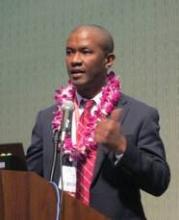HONOLULU – Eptifibatide plus medium-dose tissue plasminogen activator was safe in a phase IIb study, and a larger, phase III trial is now needed to determine whether the combination can improve ischemic stroke outcomes.
Symptomatic intracerebral hemorrhage (ICH) within 36 hours, the primary safety end point of the trial, occurred in 2% of patients randomized to the combination and in 12% given standard intravenous recombinant tissue plasminogen activator (rt-PA) alone.
A modified Rankin Scale score of 0 or 1 or return to baseline mRS at 90 days, the primary efficacy outcome, was achieved by 36% on rt-PA alone and by 49.5% on the combination. The outcome values far exceeded the 33% prespecified "no-go" criterion set for phase III evaluation, Dr. Opeolu Adeoye said on behalf of the CLEAR-ER (Combined Approach to Lysis Utilizing Eptifibatide and rt-PA in Acute Ischemic Stroke- Enhanced Regimen) trial investigators at the International Stroke Conference.
Dr. Adeoye acknowledged that "unexpected imbalances," however, existed between groups. The combination therapy group tended to be younger than the rt-PA only group (mean, 68.9 years vs. 70.9 years), had less severe strokes based on NIHSS scores (median 12 vs. 17), and had a slightly higher proportion of patients with a baseline mRS of 0 or 1 (84.2% vs. 72%).
The unadjusted odds ratio for the primary efficacy end point was 1.74, and the odds ratio was 1.38 after adjustment for age, baseline NIHSS (National Institutes of Health Stroke Scale) score, time to rt-PA, and baseline mRS. After adjustment for all but baseline mRS, the relative risk was 1.16.
"Obviously, this is a phase II study and was not designed to assess efficacy, but after adjusting for these imbalances, what we think is a clinically meaningful treatment effect persisted between groups," said Dr. Adeoye, of the University of Cincinnati Neuroscience Institute.
He noted that no obvious efficacy signal was observed in the dose-escalation, safety CLEAR Stroke trial, which was stopped early due to safety concerns about dosing rt-PA at 0.45 mg/kg over 60 minutes with a 75-mcg/kg bolus of eptifibatide followed by a 2-hour infusion at 0.75 mcg/kg/min (Stroke 2008;39:3268-76).
Among patients with myocardial infarction, combining the glycoprotein IIb/IIIa receptor inhibitor plus unfractionated heparin offered no added benefit and significantly increased the rate of bleeding in the ASSIST trial.
In CLEAR-ER, 126 ischemic stroke patients, aged 18-85 years, with an NIHSS score of more than 5 were randomized 5:1 to rt-PA 0.6 mg/kg over 40 minutes plus eptifibatide 135 mcg/kg bolus followed by a 2-hour infusion at 0.75 mcg/kg/min or standard-dose rt-PA 0.9 mg/kg. Treatment was initiated within 3 hours of symptom onset.
At day 7, symptomatic ICH rates held constant in the combination and rt-PA only groups at 2% and 12%, respectively (OR, 0.15), while asymptomatic ICH was seen in 15.8% and 12% (OR, 1.38).
At 90 days, at least one serious adverse event was reported in 26% of the combination group and 28% of the rt-PA only group. All-cause mortality rates were 20% vs. 16%, respectively, and were 15% vs. 16% for stroke-related death.
Dr. Andrei Alexandrov, director of the division of cerebrovascular disease at the University of Alabama, Birmingham, who moderated the late-breaking abstract session, questioned whether a phase III trial may be premature given that vascular imaging was not used in the current trial to determine whether vessel occlusions were present.
Dr. Adeoye responded that at the time the trial was designed, the standard of care was variable at the nine participating sites. Moreover, the data were stratified using an NIHSS score of more than or less than 12, and showed that "the bulk of the treatment effect actually appeared to be in the patients with a higher stroke scale. Not having imaging, I can’t speak to whether or not that definitely means those strokes were open; but clinically, I would venture to suggest that is what’s going on."
The conference was sponsored by the American Heart Association.
The National Heart, Lung and Blood Institute funded the study. Genentech and Merck supplied the study drugs. Dr. Adeoye reported serving as a speaker for Genentech; his coauthors reported no disclosures.


